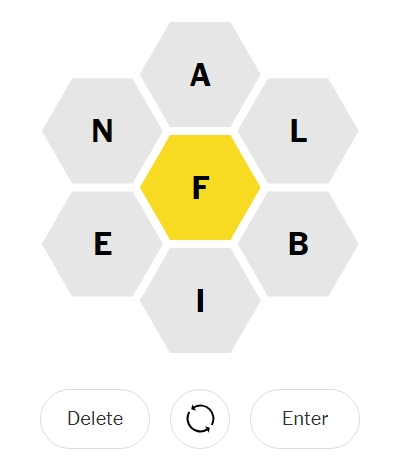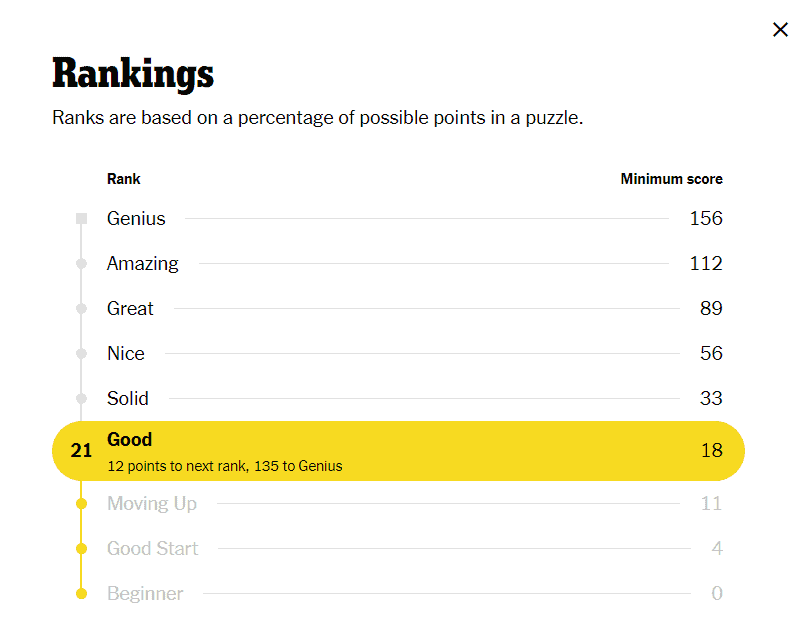Spelling Bee was originally created in 2014 by Frank Longo as a magazine feature before being adapted into a digital format four years later. Although other NYT games such as Wordle and Connections have achieved a higher level of success, Spelling Bee is also hugely popular with fans of word games and many access it at least 4 times a day!
How to play Spelling Bee
Spelling Bee is a daily game like Wordle in which players must use the given letters shaped into a honeycomb grid (which is known as the hive) to form as many words as possible. As new words are found, the player will gain points which contribute towards increasing their rank, based upon the percentage of total points available in a puzzle.

After each word is entered, Spelling Bee provides players with feedback on the words that they select. As per the NYT, there are a number of rules that the player must follow in order to have words accepted and score points:
- Each word entered must contain a minimum of 4 letters. Creating words with 3 letters or less will cause the game to display the message “too short” to the player.
- In addition to word length, players must also make sure to include the middle letter in any word they submit. Failure to include the middle letter will cause the message “missing center letter” to appear.
- The Spelling Bee word list also doesn’t include hyphenated words, proper nouns, curse words or words that are deemed to be obscure. The message “not in word list” will appear for words of these types.
- Additionally, if a player tries to input a word with a letter or letters not found in the puzzle, it will also not be accepted. When this happens, the message “bad letters” is displayed.
- However, players are permitted to enter any of the letters multiple times in order to form new words. This increases the number of potential solutions and allows for words of longer lengths.
To provide feedback to the player, the interface displays each word found, the total number of words found and total points score. These are positioned to the right of the hive on desktop and above the hive on mobile.

Players can also view their current rank and the points they need in order to achieve the next rank. The rankings overview can be viewed by clicking or tapping on the ranking bar at the top of the screen.

Spelling Bee tips and strategies
When playing Spelling Bee, it is always important to approach each round with a winning strategy in mind. By doing so, you can maximize your chances of identifying as many words as possible and start effortlessly climbing the leaderboard.
- Find variations – When starting a game of Spelling Bee, you may find it is easy to get a couple of 4 or 5 letter words solved straight away. Once these are locked down, try to find additional longer words by adding common word beginnings such as “UN” or endings such as “ED” or “ING” if the letters are available to do so.
- Rotate letters – Just underneath the letter hive you will be able to see a shuffle button that allows you to rearrange the six outermost letters of the hive. By using this each time you run out of ideas, you may be able to identify new links and patterns between the available letters to make word spotting slightly easier.
- Use official hints – Each day, the NYT posts a new Spelling Bee Forum which can be accessed by clicking on the “hints” button. The resources listed can help identify missing words to prevent you from searching for those that aren’t listed or are already played.
- The Spelling Bee Grid will show you how many words of each length can be solved for each letter.
- The Two Letter List shows the number of findable words for 2-letter starting combinations.
- Take your time – Always remember that you have 24 hours to score as highly as you can. This generous time limit should provide you the freedom to revisit the game over the course of the day, even if you have a busy lifestyle.
- Use a cheat tool – If you get really stuck, try using a cheat tool such as WordsRated’s Word Finder. To use it, enter the outside letters into the “letters” field, the central letter into the “includes” field and hit “search” to find a list of possible solutions. To find words which use the same letter multiple times, you will also need to enter them into the tool several times.
Spelling Bee points
In Spelling Bee, different word types will result in the player scoring more or less points. The table below shows you the points score for each word type, so you can know how many words of each type are needed to reach the next rank:
| Word type | Point score |
| Four-letter words | 1 point |
| Five-letter words or longer | 1 point per letter |
| Pangrams | Normal point score plus an additional 7 points |
Spelling Bee ranks
During a round of Spelling Bee, the player starts at a rank of “Beginner” and competes to rise up the leaderboard by finding as many words as possible. The table below shows you the percentage of points needed to rank up to each level:
| Rank | Percentage of points needed |
| Beginner | 0% |
| Good start | 2% |
| Moving up | 5% |
| Good | 8% |
| Solid | 15% |
| Nice | 25% |
| Great | 40% |
| Amazing | 50% |
| Genius | 70% |
| Queen Bee (hidden rank) | 100% |
Spelling Bee word list
The word list for Spelling Bee is carefully curated in order to provide the best possible challenge to players. As part of this process, the editors of the game try to create a balance of solutions, with easier words for beginners and difficult words for enthusiasts.
As the list is custom made it can result in some controversy, particularly with the game’s most dedicated players. This has typically happened when obvious words are excluded or when obscure, low-use words are included.
Multiple dictionaries and the Scrabble database are consulted prior to choosing the letters and words for each game, according to the game’s editor. What’s more, the NYT may even check Google to see how much a word has been covered in news articles published recently.
Spelling Bee terms
Due to the nature of the game, Spelling Bee makes use of various terminology. These can be used to signify and highlight elements of gameplay, playable word types and the unique ranking system.
| Term | Stands for | Meaning |
| 2LL | Two Letter List | The total number of accepted words that start with the two letters indicated. |
| BINGO | – | When each of the seven available letters can be used to start a word at least one time. |
| GN4L | Genius, No Four Letters | Achieve Genius status without finding any four letter words. |
| GN4L OTN | Genius, No Four Letters, On The Nose | Achieve Genius status by scoring the exact number of points needed, without finding any four letter words. |
| GNP(s) | Genius, No Pangram(s) | Achieve Genius status without finding any pangrams. |
| (the) Hive | – | The selection of usable letters available for each challenge. |
| Hivemind | – | A name given to the community of Spelling Bee players. |
| Pangram | – | To create a word that uses each of the given letters at least one time. |
| Perfect Pangram | – | To create a word that uses each of the given letters exactly once. |
| QB | Queen Bee | The highest status in the game, revealed only if all possible puzzle words are found. |
| QB-1 | Queen Bee -1 (One word away) | Miss out on Queen Bee status by 1 word. |
| QBABM | Queen Bee All By Myself | Achieve Queen Bee status without using additional help. |
| QBALL | Queen Bee At Long Last | Achieve Queen Bee status after trying several times. |
| QBWG | Queen Bee With Google | Achieve Queen Bee status by seeking help from Google. |
| QBWG+H+2LL | Queen Bee With Grid (Plus Hints) | Achieve Queen Bee status by using hints, Google, the grid or the two-letter list. |
When does Spelling Bee reset?
Each Spelling Bee puzzle is live for 24 hours, giving each player a full day’s play to find as many solutions as possible. The game resets at 3:00 AM Eastern Standard Time, which is the same as it is for Letter Boxed, another popular NYT game.
What does BINGO mean in Spelling Bee?
- BINGO in Spelling Bee signifies a puzzle in which each of the seven provided letters can be used to start a solution word.
- For example, if the middle letter is “S” and the outer letters are “A”, “D”, “E”, “O”, “M” and “T” a player could opt for:
- ATOMS
- DAMES
- EAST
- OATS
- MODEST
- SODA
- TAMES
- However, it is important to note that only certain Spelling Bee puzzles can form a BINGO situation as it will not always be possible to start a word with each hive letter.
What is a pangram in Spelling Bee?
- A pangram in Spelling Bee is at least seven-letters in length and happens when each of the letters in the hive is used within a solution.
- Pangrams can include the same letter(s) multiple times but if any of the letters in the hive are not used, a word cannot be a pangram.
- For example, if the letters in the hive are “A”, “C”, ”E”, “H”, “I”, “L”, and ”M”, the word “CHEMICAL” would be an example of a pangram.
What is a perfect pangram in Spelling Bee?
- Differing from an ordinary pangram, a perfect pangram uses each letter in the hive exactly once and can only be seven-letters in length.
- If any letter is used multiple times or any letter is missed out, a word cannot be a perfect pangram.
- For example if the hive’s letters are “G”, “I”, “L”, “O”, “R”, “T”, “Y”, an example of a perfect pangram would be “TRILOGY” .

